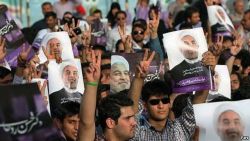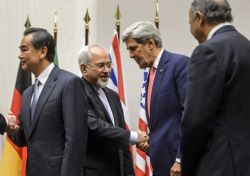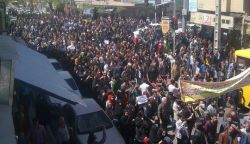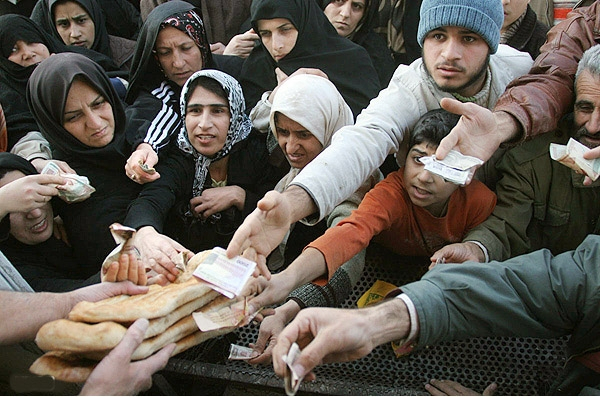As we get closer to the deadline for a deal on the nuclear negotiations, the question of “what now” is being asked by more and more people in Iran. The Rouhani government has bought itself time by turning the focus of the masses outwards to the nuclear negotiations, but sooner or later he will have to face the internal situation.
Pressures
For more than a year now the nuclear negotiations have been the main topic of discussion for most Iranians. Highly technical terms and concepts regarding the levels of enrichment of uranium and the workings of nuclear centrifuges are common knowledge to people, whether they be pensioners or six year-old children. The interest with which every Iranian is looking at this question is an indication of the pressures which are present below the surface of society. During the first year of the Rouhani government, the pressing problems of the Iranian masses have not been solved.
While official unemployment figures stand at around 10 percent, only 22 million of the 53.25 million population between 15 and 65 years of age are in employment. And while Hassan Rouhani has been praised for “taming inflation” from the historic 40+ percent, it is still very high at 17 percent. Under the pressure of poverty and inflation, real household consumption fell by 5 percent for urban families and 12 percent for rural ones. Their real food expenditure fell by 14 percent.
In the new Iranian year (which started on 21 March) the minimum wage was only raised 25 percent, far below what the workers lost to inflation. The poverty line for a family of four is set at 3 times the the official minimum wage - which is far from being guaranteed to all Iranian workers. One figure highlights the real situation: 93 percent of workers who are lucky enough to have a labour contract are temporary, while more than 50 percent of all workers are employed on so-called “blank contracts” which do not give them any rights whatsoever.
Furthermore, the removal of subsidies has hit the working masses hard. Fuel prices alone have almost doubled this year, while utility prices have gone up 20-40 percent . At the same time the state cash handouts that were supposed to cover for the subsidy cuts and which were a lifeline for the poorest, have not been raised at all, meaning that they have lost significant value to inflation. The real situation is much worse than the sant (official) figures would indicate.
None of the losses that the average Iranian family suffered during the Ahmadinejad era have been made up for, in spite of Rouhani’s claim to represent a change in the situation. On the contrary, the government has slashed spending by 37%. However, in spite of all the austerity measures, real growth has not returned and the situation is getting worse.
The Joint Action Plan interim deal with the West was supposed to change this. Thus, in industry we saw a 90% increase in light auto production, 30% in home durables, 9% in steel, and 6% in petrochemicals. However, according to the government's own figures, more than 700.000 jobs were lost in industry in the same period. Along with agriculture, around one million jobs have been lost. This indicates that although production was rising, this was on the basis of a further exploitation of the working class.
As long as the negotiations are ongoing, however, the masses are prepared to hold their breath. But once the negotiations are over, the demand for a decent living will surface again with a vengeance.
Without legitimacy
 The 2009 mass movement was defeated, but none of the underlying problems have been solved. In the years since that moment, the anger has episodically breached the surface. The election of Rouhani himself was a clear warning. Rouhani does not represent the people in any way. However, the masses saw his election campaign as a way of coming out and showing their opposition to the status quo. This was a clear message to the regime.
The 2009 mass movement was defeated, but none of the underlying problems have been solved. In the years since that moment, the anger has episodically breached the surface. The election of Rouhani himself was a clear warning. Rouhani does not represent the people in any way. However, the masses saw his election campaign as a way of coming out and showing their opposition to the status quo. This was a clear message to the regime.
Among the young generation the legitimacy of the Islamic Republic is extremely low. For them the Islamic Revolution has no progressive content, but is merely a symbol of dictatorship, backwardness and decay. Even for the old Khomeinists who would once die for the bloody counter-revolution, the Islamic Republic has lost its appeal. The rottenness and corruption behind the scenes is very far from the pious ideals that the mullahs hypocritically preach. The continuous corruption scandals and the open participation of the clergy in prostitution and other criminal enterprises is a daily reminder of their fraud.
 While they ask the poor to endure the worst hardships, they themselves live in palatial mansions and spend their holidays in luxurious surroundings in the countryside. The obscene wealth and the decadent lifestyle of the elite, which was recently displayed worldwide through the “richkidsoftehran” instagram account, is in stark contrast to the simple life and the humility preached by the regime.
While they ask the poor to endure the worst hardships, they themselves live in palatial mansions and spend their holidays in luxurious surroundings in the countryside. The obscene wealth and the decadent lifestyle of the elite, which was recently displayed worldwide through the “richkidsoftehran” instagram account, is in stark contrast to the simple life and the humility preached by the regime.
The most intelligent sections of the ruling class can see what has been happening to the dictatorships in the region. They understand that they must change course if they are to avoid an explosion from below. However, opening up from above can also lead to the seething anger coming to the surface in the form of uncontrollable explosion. That is one of the reasons why they are desperately seeking a deal with the West which could open up the country for investments and give them the economic buffer to manage the shift within the regime.
The new power in the Middle East
For the US there is little choice in the matter of the negotiations. After the destruction of Saddam’s army during the Iraq war, the main competitor to Iran’s army in the region was removed. That, coupled with the weak Arab regimes, the Arab revolutions and the decline of US imperialism, left Iran as the main power in the Middle East. Over the past two years it has been an invaluable collaborator of US imperialism across the region.
In Syria for the past year, the actions of the US have been far more aligned with the needs of Assad and Hezbollah than those of its official partners in Turkey and the Gulf States who have been behind the Islamist movement. In Lebanon they are equally dependent on Hezbollah to keep the country from falling apart. In Iraq their cooperation goes back almost a decade. However, the recent disintegration of the country has accelerated the process. With the Americans bombing and the Revolutionary Guards running the battle on the ground, de facto cooperation between the two countries has not been closer over the past 35 years.
 Acknowledging this fact, a choir of US strategists, as well as Hassan Rouhani and Commander of the Revolutionary Guards, Mohammad Ali Jaffari, have on several occasions repeated Jimmy Carter's’ famous words about the Pahlavi regime, describing Iran as an “island of stability”. At that time Carter was describing the role of Iran as one of the most important and reliable allies of the United States. Today a similar albeit contradictory dependence is forming.
Acknowledging this fact, a choir of US strategists, as well as Hassan Rouhani and Commander of the Revolutionary Guards, Mohammad Ali Jaffari, have on several occasions repeated Jimmy Carter's’ famous words about the Pahlavi regime, describing Iran as an “island of stability”. At that time Carter was describing the role of Iran as one of the most important and reliable allies of the United States. Today a similar albeit contradictory dependence is forming.
This is an established fact. The real essence of the nuclear negotiations are not to determine the strength of Iran, but to formalise the new balance of forces in the region. In return for its services, the Iranian ruling class is demanding access to Western markets as well as investments from the West in Iran. They want to modernise the Iranian economy and bring it up to the level of western economies.
Whether the deal will actually be signed or whether it will merely be carried out surreptitiously through the backdoor, is not certain. But the final result is quite clear and cannot be changed by any negotiation.
A deal with the US will also mean a major change in the domestic strategy of the regime. For thirty years the regime has used the threat of US imperialism to unite the nation behind it, to dilute the class contradictions and to hide the parasitic nature of the dictatorship of the clergy. But the new new detente with the US will anger many who had previously supported the regime against the “great satan”. As the relationship between the countries becomes warmer, a large layer of regime supporters will melt away. For thirty years they have been told to buckle up and make sacrifices to defend their country against US imperialism, but now this excuse no longer holds.
Class struggle
Initially, however, the regime will be strengthened. The easing of sanctions will mean a certain degree of revival of a dead Iranian economy. This will be felt everywhere. The new position of Iran in the region and the blows that it has struck against the US will also lift national pride which will further bolster the regime in the short run.
However, any easing of pressure from the top will also embolden the workers’ struggle. The anger which has been pent up during decades of ruthless exploitation and oppression will come to the surface as the workers will attempt to secure their share.
In this, the interests of the ruling class will be directly opposed to those of the workers. In such conditions, they would have to attack living standards. They have already announced their agenda.
Last February, Supreme Leader, Ali Khamenei, issued a decree introducing the general policies of Iran’s “Resistance Economy” - a policy to which President Rouhani fully subscribes. The key elements in this plan are the points about the increase in “efficiency” and “Total factor productivity”. These are merely other words for lifting productivity by lowering wages and raising the intensity of labour.
The main problem for Iranian capitalism has always been the low level of productivity, which is caused by the parasitic nature of the bourgeoisie who has been more inclined to plunder and steal than to invest and build. Apart from the outdated and worn out industry, the country has a relatively weak infrastructure and a low scientific and technological level. For the bourgeois, the only way to make up for this weakness, in pursuit of real investments in industry - apart from the oil industry - is for the regime to lower labour costs.
The government is now using inflation and the devaluation of the Rial to partially achieve this. However, the future will see further direct attacks to bring down the cost of labour. The official minimum wage at $248, is still far above similar countries, such as Bangladesh, where the entry level minimum wage for garment workers is $70 a month.
The ruling class wants Iran to attain a position similar to Turkey or Brazil, but what they attempt to hide is the immense inequality which has been the price for the development of these economies. Of course, this does not mean that Marxists are against investments. Any real economic growth, such as investments in production and industry, would also strengthen the working class by organising it, expanding it and raising the economic levers that it could potentially control.
Growth in itself would, however, not be able to solve the problems of the working class. Capitalism worldwide today is in a deep crisis. It has no room for concessions. On a capitalist basis, any growth would only be at the expense of the working class and would deepen the class divide. At the same time the situation will be worse than in countries such as Turkey which developed in a period of steep economic upswing on a global scale. Today the competition between nations, for markets and to attract investments, will be much fiercer and the the price will have to be paid by the masses. Any economic development will only benefit a thin layer at the top, while the mass of people will be forced to fight for the crumbs. This is a finished recipe for class struggle.
Bafgh - a glimpse of the future
 Thousands protested in BafghAlthough it is still very early days, a glimpse of future events was seen in the mining town of Bafgh in May and June. Here 5000 iron ore miners came out on strike for 45 days - making it the longest strike since the 1979 revolution - and successfully blocked the privatisation of the mine. Again, in August the workers were on strike for 16 days as their leaders were arrested.
Thousands protested in BafghAlthough it is still very early days, a glimpse of future events was seen in the mining town of Bafgh in May and June. Here 5000 iron ore miners came out on strike for 45 days - making it the longest strike since the 1979 revolution - and successfully blocked the privatisation of the mine. Again, in August the workers were on strike for 16 days as their leaders were arrested.
In the absence of independent workers’ organisations, the movement was organised through the state controlled unions, and one of the main leaders of the strike was the chairman of the Islamic Town Council. This didn’t affect the efficiency of the strike, however, and in the end every demand of the workers was met.
As opposed to previous years, the workers have been on the move this year with a series of offensive strikes. In Chadormalu, 3000 mineworkers struck for higher wages and in the East Alborz coal mine 1400 workers went on strike against privatisation measures. These strikes have been drawing in the heavy battalions of the working class in offensive struggles, whereas previously the vast majority of the struggles would be by laid off or unpaid, casual workers, often fringe sectors, desperately struggling for their rights.
The new developments indicate that the tide is beginning to turn for the workers’ movement. These movements show the embryo of future developments. The explosive nature of the Bafgh strike in particular and its immediate advanced political nature shows that, contrary to the belief of many “educated” people, the consciousness of the workers is quite high.
The main obstacle for the working class has been the lack of a revolutionary party to organise and lead it in struggle. However, in the above strikes we also see that once the point is reached where the workers decide to go into struggle, they will not necessarily wait for ideal organisations to be built. In the absence of their own organisations, the workers will use whatever is at their disposal in their struggles, even the city council and the reactionary state unions.
There are lessons in all this that revolutionaries must study today to understand the movement of tomorrow. After the resolution of the Nuclear Issue - however it may end - the class struggle will begin to sharpen up and sudden explosions could occur. Only one year after Jimmy Carter had called Iran “an island of stability” the Pahlavi dynasty was overthrown by the 1979 revolution. In a similar way today’s apparent calm on the surface can betray the eye.
Frustration and dissatisfaction is present in every pore of Iranian society. The regime knows that it cannot continue to hold the pressure back, but at the same time every attempt to loosen up will be met with explosive developments. The workers’ movement will once again move to the centre of the scene. Capitalism is organically incapable of solving any of the burning problems of the Iranian masses and therefore they will inevitably be forced to take the revolutionary path once more.
In this context, the Communist traditions of the past will be revived and the the Marxists will find fertile ground for their ideas. The task today is to study the past and the present, as well as the ideas of Marxism, in order to prepare for the events that will inevitably unfold in the coming period.

